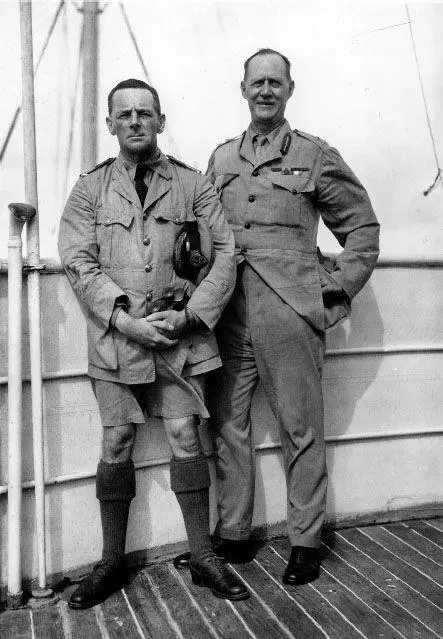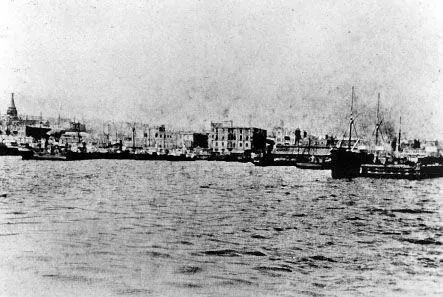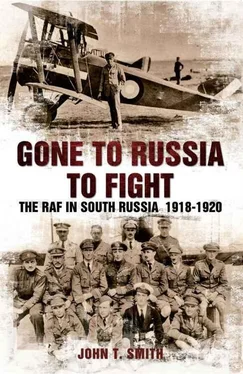A small party of British forces had been waiting in north Persia to be invited into Baku. This was under the command of Major General Lionel Dunsterville. Composed mainly of Army officers, this small force had set out from Baghdad with forty-one Ford model T cars and vans to drive the 700 miles north-east to the Caspian Sea. After many adventures, this group was waiting in the port of Enzeli on the south Caspian shore. Commodore David Norris and twenty-two ratings were the Naval element of this force.
The area of operations for Dunsterforce.

Left: Commodore David Norris. Right: General Lionel Dunsterville.
The British aims were to keep the oil from Baku out of the hands of the Germans and the Turks. Also, the main rail line from Moscow to the area north of British India ran down through the Caucasus (the route continued across the Caspian by ship, and then from Krasnovodsk on the eastern shore to Afghanistan): it was the aim of the British to prevent the spread of Bolshevism to India by controlling the Caspian link. Commodore Norris had left Baghdad on 27 July 1918 with one four-inch gun and two twelve-pounders. Very little was known of the conditions on the Caspian and no charts were available, as no Royal Navy ships had ever sailed on it. It was not even known if suitable merchant ships would be available to mount the guns on.
The route from Baghdad to Enzeli ran for 700 miles of mule and camel tracks. Most of the way was through high mountainous regions. The Ford vans could only carry just enough fuel to reach Enzeli. On 5 August, Norris arrived at Enzeli and had his first sight of the Caspian. Money was paid by the British to the local authorities at Enzeli to allow them to use the port. General Dunsterville was anxious to obtain the shipping needed to move his forces to Baku. All the available Naval personnel and guns from the Far East were beginning to make the long trek overland to the Caspian Sea. Army reinforcements also began to move forward from Baghdad to reinforce General Dunsterville.
The first ship chartered by the Navy was the SS President Kruger . On 16 August 1918, General Dunsterville and his staff, along with Commodore Norris, set sail for Baku in the Kruger , arriving the following day. Baku was the largest port on the Caspian, and the population had increased with the influx of people to work in the oil industry. Parts of the town were made up of large modern buildings, but other parts were only shacks separated by cart tracks. To the west of the town, was a large oil-field and refinery. The population was a mix of Armenian, Russian, and Azerbaijani.
Most of the fighting against the Turks was being done by Armenian troops. As soon as even a small number of British troops arrived, the Armenians considered that they had done enough fighting and many of the troops returned to Baku. But General Dunsterville pointed out that the British could only supply limited numbers of troops, and the intention was only to provide support for the Armenians. Two more ships, the SS Kursk and the SS Abo , were taken over by the British. As the Army and Navy reinforcement arrived in Enzeli, they were shipped across the Caspian to Baku. Dunsterville only had around 1,200 British troops to support 8,000 Armenian troops against the 14,000-strong Turkish forces. Also, most of the surviving Azerbaijanis, after the massacre in Baku, were now working for the Turks.

The seafront at Baku.
The Turks launched a major attack towards Baku on 26 August. British forces were driven back from a defensive position called the Mud Volcano. Two local battalions had been ordered forward to support the British troops but had never appeared at the front. This had given General Dunsterville extreme misgivings about the vulnerability of the British. Another major attack was launched on 31 August and again the British were forced back. The numbers of British casualties continued to rise. During this action, General Dunsterville witnessed an entire Russian battalion leave the front and flee.
General Dunsterville called all the different groups in Baku to the Hotel Europa on 1 September. He stated that unless they were prepared to fight, then no power on earth could save them from the Turks. All the parties involved agreed that things would change. The Turks did not carry out any more advances for the next two weeks.
The air support for the British force was to be provided by aircraft from 72 Squadron. This squadron was nominally based at Baghdad but had been broken into separate flights. A Flight was based at Samara and equipped with DH4s and SE5As. C Flight was at Marjiana with Bristol monoplanes. B Flight had been operating with the Army in north Persia against local insurgents known colloquially as the Jungalies. The squadron diary reads:
The bombing raids that followed on the Jungalies so completely demoralised them, that the mere sight of Aeroplanes put them to flight, and our troops were able to occupy Resht. [1]
B Flight was stationed on the airfield at Hamadan in north Persia. They were equipped with Martinsyde G.102 Elephants, large single-seat reconnaissance aircraft. Lieutenant A. A. Cullen, who was part of A Flight but also flew the Martinsyde, described the aircraft:
Jumbo Martinsyde, a big rather clumsy single seater, with a 150 HP Beardmore engine, originally designed for long reconnaissance flights. [2]
Two Martinsydes were sent from Hamadan to support the British forces in Baku. On 15 August 1918, Lieutenants M. C. Mackay and R. P. P. Pope were told to prepare their aircraft for the trip to Baku. On 18 August, the aircraft were flown to Enzeli, where they were dismantled and stripped to enable them to be carried on a ship. The Turks held most of the coast and it was not thought a good idea to fly the aircraft direct. The airfield at Baku was four miles outside the town. After they were unloaded onto the docks, the aircraft were taken to the airfield by truck. By 25 August, the aircraft had been reassembled and a two-hour test flight using local petrol was successfully carried out.
False reports were received that German fighter aircraft were operating with the Turks at Baku. To counter this threat, it was decided to send three of A Flight’s SE5As to Baku. The aircraft were sent forward from Baghdad. The pilots were Lieutenants A. A. Cullen, Pitt, and Cannel. On 19 August, Lieutenant Cullen crashed his SE5A while landing at an airfield at Kermanshah. The next day, he was forced to follow the other two SE5As by car to Hamadan. On 21 August, Lieutenant Cannel crashed his SE5A while taking off from Hamadan. Later in the month, Lieutenant Cullen made a forced landing behind Turkish lines while carrying out a reconnaissance flight and was taken prisoner. The plan to send the SE5As to Baku was abandoned.
General Dunsterville only had the two Martinsydes and two Russian flying boats operating from the harbour at Baku as effective aircraft. There were other Russian aircraft operating from the airfield outside the town, but they did not provide effective support. The squadron diary states:
On the 27th August Major Boyd, visited Baku with Captain Fuller and in his report on Aviation generally, remarked on the little enterprise by the Russian Pilots, and as they did not appear to understand the first rudiments of war flying, we were prepared not to receive much support from them. [3]
General Dunsterville did what he could with the limited forces at his command. But the expedition was doomed from the start.
Читать дальше














